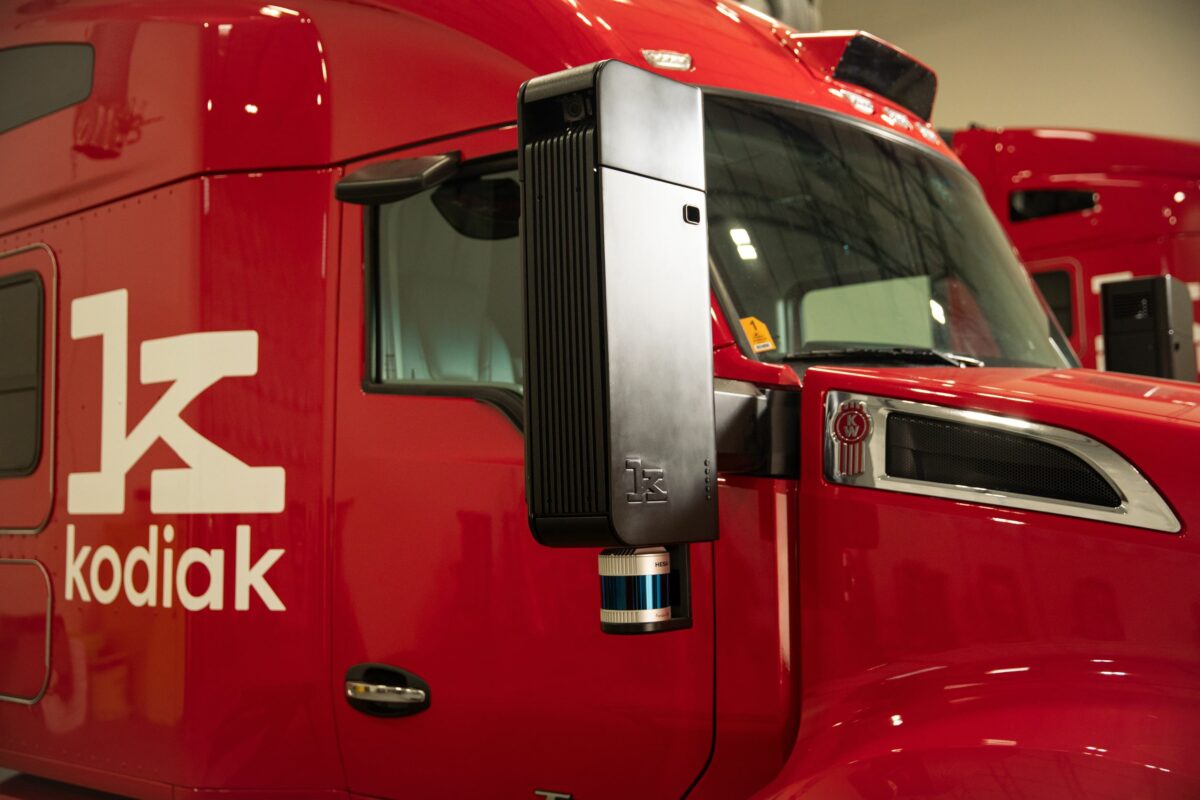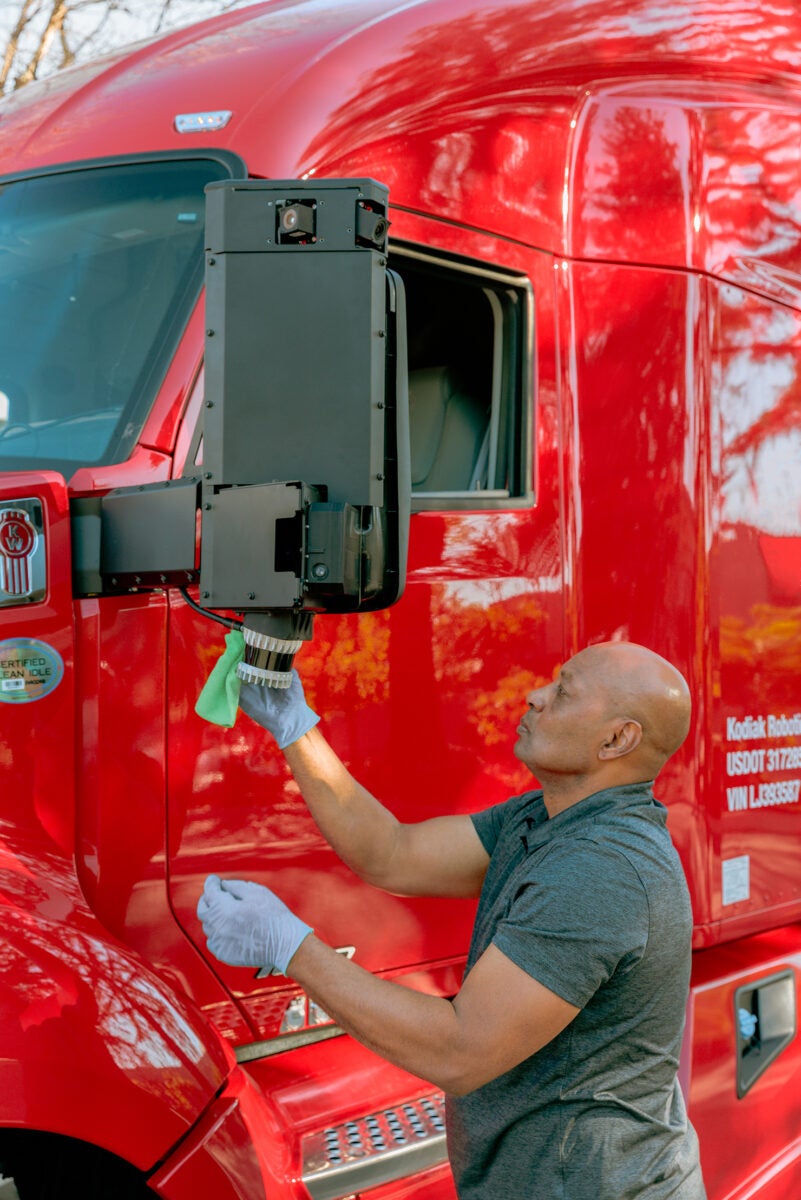Editor’s Note: CORRECTS Ottomoto purchaser to Uber instead of Aurora
The appearance of autonomous vehicles has come a long way since the days of “rotating chicken buckets,” as one lidar product was known.
With its fourth-generation truck, self-driving truck developer Kodiak Robotics is matching a functional aesthetic with easier maintenance.
“From the beginning of Kodiak, we have always tried really hard to thoughtfully integrate our technology into the platform,” CEO Don Burnette told FreightWaves in an interview. “There’s been a history of self-driving companies that have hacked into vehicles and prototyped in the most ugly and unsophisticated of ways in order to push the technology forward.
“As an industry, we want to really show off the Frankenstein-ishness of the tech, if you will. But now I think we’re much past that.”
Kodiak robotics CEO Don Burnette
“As an industry, we want to really show off the Frankenstein-ishness of the tech, if you will,” he said. “But now I think we’re much past that.”
Major Kodiak hardware now occupies just three places on the truck — a slim profile “center pod” on the front roofline and pods integrated into the required 50-inch side mirrors.

“That type of modularity is incredibly important for in-field maintenance,” Burnette said. “You can imagine needing to have AV technicians that can go in and diagnose or fix or repair little camera features that are embedded deep into these assemblies. Being able to pull a mirror pod off, put a new mirror pod that’s already fully internally calibrated onto a truck, and then send it on its way is incredibly powerful for the industry.”
To Burnette, it is worth the effort to make the truck look as good as it reliably performs. On the other side of the mirror, a driver gets “exactly the same visibility you would with a stock mirror,” he said. “The best hardware modifications should be barely visible,” he said.
Updates galore
In a press release Tuesday, Kodiak provided several updates to its progress of getting driverless trucks on the road in the next couple of years.
Kodiak has ordered 15 trucks from Paccar, maker of Kenworth and Peterbilt models, that will more than double the size of its test fleet of 11 trucks at the end of 2020. Kodiak will own and operate the trucks as it runs freight in Texas and other Southwestern states for customers to whom it eventually wants to sell its Level 4 high-autonomy technology.
The fourth-generation truck features Luminar’s Iris horizontal and vertical lidar capable of seeing 1,968 feet, more than a third of a mile; ZF Full Range Radar; and 360-degree scanning lidars from Hesai for side and rear-view detection.
Radars, lidars and cameras are managed by Kodiak’s Vision system that fuses the information from the sensors, cross validating data while considering the relative strengths and weaknesses of each depending on the driving environment. Each side mirror pod contains one lidar, two four-dimensional radars and three cameras.
The new tractors will be equipped with Cummins X15 Series engines with the engine maker’s ADS Powertrain interface that allows the autonomous system to communicate with the engine.
The Nvidia Orin supercomputing platform will handle the 250 trillion operations per second of data generated when it becomes available. The current generation Nvidia Drive AGX Pegasus will process camera-generated data until then.
A generic approach
Like San Francisco-based neighbor Embark Trucks, Kodiak sees itself as a technology provider to trucking fleets.
“Our goal is not to become a fleet ourselves that is directly competing with carriers and fleets that are out there today.” Burnette said.
That means the hardware and software being developed would work on any manufacturer’s truck. Burnette prefers the word generic to agnostic, favored by Embark and suppliers like Cummins and ZF.
“We built our system to be generic. We believe we [could deploy] our modular mirror pod technology on any OEM platform,” he said.

Burnette agrees that fully autonomous trucks could hit the roads sooner than once expected, albeit in limited numbers.
“I think you’re going to start to see self-driving trucks on the road, in some capacity, without a driver in the next couple of years,” Burnette said. “Whether that’s 2023, whether that’s 2024, I don’t have a crystal ball. Neither does anyone else. But I think that is a realistic target, and that is the target that Kodiak is also marching toward.”
Going public can wait
Kodiak, founded in 2018 by Burnette and venture capitalist Paz Eshel, has attracted less attention than competitors, in part because it has not said much about going public.
TuSimple, founded in 2015, was the first of the autonomous trucking startups to go public via a traditional initial public offering in April. Three others — Aurora Innovation, Embark Trucks and Plus — are in defined mergers with special purpose acquisition companies sponsoring them for public trading. Kodiak and Google-backed Waymo Via have stayed out of the SPAC frenzy.
“We are incredibly strong right now,” Burnette said of the Mountain View, California-based startup, the third with which he has been involved. The first was the vaunted Google self-driving car program that dates to 2009. He co-founded now defunct Ottomoto LLC in 2016 and left after it was purchased by Uber but before it was shut down.
“We have an ultimate goal and plan to become a public company at some point. The question is when, and what is the appropriate path for Kodiak? There’s no immediate need to make a significant move in that regard.
KODIAK ROBOTICS CEO DON BURNETTE
Kodiak has grown to about 85 employees, including 11 safety drivers who supervise autonomous testing.
“We’re hiring across the board, across all of our teams. We are beefing up our fleet,” Burnette said. “We have amazing partners on the technical side, and we are going to be making some big announcements soon about commercial partners that we’re working with as well.”
For now, the SPAC parade appears to have passed Kodiak by. Burnette does not appear concerned.
“We have an ultimate goal and plan to become a public company at some point,” he said. “The question is when, and what is the appropriate path for Kodiak? There’s no immediate need to make a significant move in that regard. But each day we’ll continue to evaluate what our options are and what is the best path for Kodiak.”
Related articles:
Can Kodiak compete with the big boys of autonomous trucking?
SK partnership brings Kodiak Robotics’ autonomous technology to Asia
Kodiak Robotics getting more than tire data from Bridgestone partnership








N/A
Autonomous vehicle companies are partnering with tire manufacturers (Bridgestone, Goodyear) and implementing smart-sensing tire technology. One of the benefits is not needing to scale in/out at the shipper because pressure sensors on the tires can tell you if you’re loaded to legal limit, overloaded on an axle, etc. Drivers jobs will not be eliminated, they’ll just move to more local/regional jobs to where they’ll be home each night. Net positive for the industry.
Tcs53
Just wondering, how do you sleep at night? There’s really no need for these things, the only goal is to eliminate the driver. Is there technology to stop at a weigh station? If so, what happens if the truck is overweight or can’t pass a roadside inspection? Free pass? Who gets the ticket and points on their license?
commenter
Otto was bought by uber not aurora.